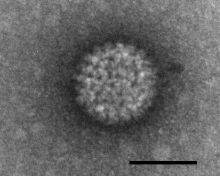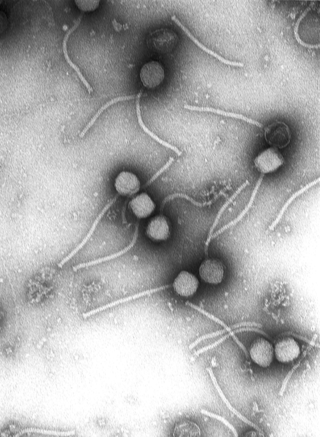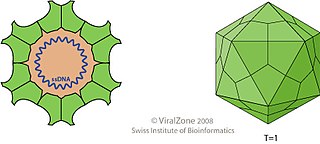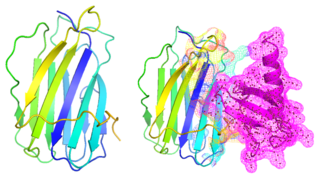
Veterinary virology is the study of viruses in non-human animals. It is an important branch of veterinary medicine.

Veterinary virology is the study of viruses in non-human animals. It is an important branch of veterinary medicine.

Rhabdoviruses are a diverse family of single stranded, negative sense RNA viruses that infect a wide range of hosts, from plants and insects, to fish and mammals. The Rhaboviridae family consists of six genera, two of which, cytorhabdoviruses and nucleorhabdoviruses, only infect plants. Novirhabdoviruses infect fish, and vesiculovirus, lyssavirus and ephemerovirus infect mammals, fish and invertebrates. The family includes pathogens such as rabies virus, vesicular stomatitis virus and potato yellow dwarf virus that are of public health, veterinary, and agricultural significance. [1]
Foot-and-mouth disease virus (FMDV) is a member of the Aphthovirus genus in the Picornaviridae family and is the cause of foot-and-mouth disease in pigs, cattle, sheep and goats. It is a non-enveloped, positive strand, RNA virus. FMDV is a highly contagious virus. It enters the body through inhalation. [2]
Pestiviruses have a single stranded, positive-sense RNA genomes. They cause Classical swine fever (CSF) and Bovine viral diarrhea(BVD). Mucosal disease is a distinct, chronic persistent infection, whereas BVD is an acute infection. [3]
Arteriviruses are small, enveloped, animal viruses with an icosahedral core containing a positive-sense RNA genome. The family includes equine arteritis virus (EAV), porcine reproductive and respiratory syndrome virus (PRRSV), lactate dehydrogenase elevating virus (LDV) of mice and simian haemorrhagic fever virus (SHFV). [4]
Coronaviruses are enveloped viruses with a positive-sense RNA genome and with a nucleocapsid of helical symmetry. They infect the upper respiratory and gastrointestinal tract of mammals and birds. They are the cause of a wide range of diseases in cats, dog, pigs, rodents, cattle and humans. Transmission is by the faecal-oral route. [5]
Torovirus is a genus of viruses within the family Coronaviridae , subfamily Torovirinae that primarily infect vertebrates and include Berne virus of horses and Breda virus of cattle. They cause gastroenteritis in mammals, including humans but rarely. [6]
Influenza is caused by RNA viruses of the family Orthomyxoviridae and affects birds and mammals.
Wild aquatic birds are the natural hosts for a large variety of influenza A viruses. Occasionally viruses are transmitted from this reservoir to other species and may then cause devastating outbreaks in domestic poultry or give rise to human influenza pandemics. Edward J Dubovi, MacLachlan NJ (2010). Fenner's Veterinary Virology, Fourth Edition. Boston: Academic Press. p. 365. ISBN 978-0-12-375158-4.{{cite book}}: CS1 maint: overridden setting (link)
Bluetongue virus (BTV), a member of Orbivirus genus within the Reoviridae family causes serious disease in livestock (sheep, goat, cattle). It is non-enveloped, double-stranded RNA virus. The genome is segmented. [7] [8]
Circoviruses are small single-stranded DNA viruses. There are two genera: gyrovirus, with one species called chicken anemia virus; and circovirus, which includes porcine circovirus types 1 and 2, psittacine beak and feather disease virus, pigeon circovirus, canary circovirus, goose circovirus. [9]
Herpesviruses are ubiquitous pathogens infecting a variety of animals, including humans. Hosts include many economically important species such as abalone, oysters, salmon, poultry (avian infectious laryngotracheitis, Marek's disease), cattle (bovine malignant catarrhal fever), dogs, goats, horses, cats (feline viral rhinotracheitis), and pigs (pseudorabies). [10] Infections may be severe and may result in fatalities or reduced productivity. Therefore, outbreaks of herpesviruses in livestock cause significant financial losses and are an important area of study in veterinary virology.
African swine fever virus (ASFV) is a large double-stranded DNA virus which replicates in the cytoplasm of infected cells and is the only member of the Asfarviridae family. The virus causes a lethal haemorraghic disease in domestic pigs. Some strains can cause death of animals within as little as a week after infection. In other species, the virus causes no obvious disease. ASFV is endemic to sub-Saharan Africa and exists in the wild through a cycle of infection between ticks and wild pigs, bushpigs and warthogs. [11]
Retroviruses are established pathogens of veterinary importance. They are generally a cause of cancer or immune deficiency. [12]
Flaviviruses constitute a family of linear, single-stranded RNA(+) viruses. Flaviviruses include the West Nile virus, dengue virus, Tick-borne Encephalitis Virus, Yellow Fever Virus, and several other viruses. Many flavivirus species can replicate in both mammalian and insect cells. Most flaviviruses are arthropod borne and multiply in both vertebrates and arthropods. The viruses in this family that are of veterinary importance include Japanese encephalitis virus, St. Louis encephalitis virus, West Nile virus, Israel turkey meningoencephalomyelitis virus, Sitiawan virus, Wesselsbron virus, yellow fever virus and the tick-borne flaviviruses e.g. louping ill virus. [13]
Paramyxoviruses are a diverse family of non-segmented negative strand RNA viruses that include many highly pathogenic viruses affecting humans, animals, and birds. These include canine distemper virus (dogs), phocine distemper virus (seals), cetacean morbillivirus (dolphins and porpoises) Newcastle disease virus (birds) and rinderpest virus (cattle). Some paramyxoviruses such as the henipaviruses are zoonotic pathogens, occurring primarily in an animal hosts, but also able to infect humans. [14]
Parvoviruses are linear, non-segmented single-stranded DNA viruses, with an average genome size of 5000 nucleotides. They are classified as group II viruses in Baltimore classification of viruses. Parvoviruses are among the smallest viruses (hence the name, from Latin parvus meaning small) and are 18–28 nm in diameter. [15]
Parvoviruses can cause disease in some animals, including starfish and humans. Because the viruses require actively dividing cells to replicate, the type of tissue infected varies with the age of the animal. The gastrointestinal tract and lymphatic system can be affected at any age, leading to vomiting, diarrhea and immunosuppression but cerebellar hypoplasia is only seen in cats that were infected in the womb or at less than two weeks of age, and disease of the myocardium is seen in puppies infected between the ages of three and eight weeks. [16]

Virology is the scientific study of biological viruses. It is a subfield of microbiology that focuses on their detection, structure, classification and evolution, their methods of infection and exploitation of host cells for reproduction, their interaction with host organism physiology and immunity, the diseases they cause, the techniques to isolate and culture them, and their use in research and therapy.

Flaviviridae is a family of enveloped positive-strand RNA viruses which mainly infect mammals and birds. They are primarily spread through arthropod vectors. The family gets its name from the yellow fever virus; flavus is Latin for "yellow", and yellow fever in turn was named because of its propensity to cause jaundice in victims. There are 89 species in the family divided among four genera. Diseases associated with the group include: hepatitis (hepaciviruses), hemorrhagic syndromes, fatal mucosal disease (pestiviruses), hemorrhagic fever, encephalitis, and the birth defect microcephaly (flaviviruses).
Viral evolution is a subfield of evolutionary biology and virology that is specifically concerned with the evolution of viruses. Viruses have short generation times, and many—in particular RNA viruses—have relatively high mutation rates. Although most viral mutations confer no benefit and often even prove deleterious to viruses, the rapid rate of viral mutation combined with natural selection allows viruses to quickly adapt to changes in their host environment. In addition, because viruses typically produce many copies in an infected host, mutated genes can be passed on to many offspring quickly. Although the chance of mutations and evolution can change depending on the type of virus, viruses overall have high chances for mutations.

Arteriviridae is a family of enveloped, positive-strand RNA viruses in the order Nidovirales which infect vertebrates. Host organisms include equids, pigs, Possums, nonhuman primates, and rodents. The family includes, for example, equine arteritis virus in horses which causes mild-to-severe respiratory disease and reproductive failure, porcine reproductive and respiratory syndrome virus type 1 and type 2 in pigs which causes a similar disease, simian hemorrhagic fever virus which causes a highly lethal fever, lactate dehydrogenase–elevating virus which affects mice, and wobbly possum disease virus.

Carnivore protoparvovirus 1 is a species of parvovirus that infects carnivorans. It causes a highly contagious disease in both dogs and cats separately. The disease is generally divided into two major genogroups: FPV containing the classical feline panleukopenia virus (FPLV), and CPV-2 containing the canine parvovirus type 2 (CPV-2) which appeared in the 1970s.
Avian coronavirus is a species of virus from the genus Gammacoronavirus that infects birds; since 2018, all gammacoronaviruses which infect birds have been classified as this single species. The strain of avian coronavirus previously known as infectious bronchitis virus (IBV) is the only coronavirus that infects chickens. It causes avian infectious bronchitis, a highly infectious disease that affects the respiratory tract, gut, kidney and reproductive system. IBV affects the performance of both meat-producing and egg-producing chickens and is responsible for substantial economic loss within the poultry industry. The strain of avian coronavirus previously classified as Turkey coronavirus causes gastrointestinal disease in turkeys.

Astroviruses (Astroviridae) are a type of virus that was first discovered in 1975 using electron microscopes following an outbreak of diarrhea in humans. In addition to humans, astroviruses have now been isolated from numerous mammalian animal species and from avian species such as ducks, chickens, and turkey poults. Astroviruses are 28–35 nm diameter, icosahedral viruses that have a characteristic five- or six-pointed star-like surface structure when viewed by electron microscopy. Along with the Picornaviridae and the Caliciviridae, the Astroviridae comprise a third family of nonenveloped viruses whose genome is composed of plus-sense, single-stranded RNA. Astrovirus has a non-segmented, single stranded, positive sense RNA genome within a non-enveloped icosahedral capsid. Human astroviruses have been shown in numerous studies to be an important cause of gastroenteritis in young children worldwide. In animals, Astroviruses also cause infection of the gastrointestinal tract but may also result in encephalitis, hepatitis (avian) and nephritis (avian).

Porcine circovirus (PCV) is a group of four single-stranded DNA viruses that are non-enveloped with an unsegmented circular genome. They are members of the genus Circovirus that can infect pigs. The viral capsid is icosahedral and approximately 17 nm in diameter.

Ectromelia virus (ECTV) is a virus of the family Poxviridae and the genus Orthopoxvirus that causes mousepox, a disease of mice. It has only been seen in mouse colonies kept for research purposes but believed that wild populations of mice and other rodents in Europe are naturally infected with ECTV. Mousepox causes skin lesions, a purulent rash on the body of mice, and generalized disease, which can be fatal. It is the only poxvirus to cause disease naturally in mice.

Bovine papular stomatitis is a farmyard pox caused by Bovine papular stomatitis virus (BPSV), which can spread from infected cattle to cause disease in milkers, farmers and veterinarians. Generally there is usually one or a few skin lesions typically on the hands or forearm. The disease is generally mild.
A chimera or chimeric virus is a virus that contains genetic material derived from two or more distinct viruses. It is defined by the Center for Veterinary Biologics as a "new hybrid microorganism created by joining nucleic acid fragments from two or more different microorganisms in which each of at least two of the fragments contain essential genes necessary for replication." The term genetic chimera had already been defined to mean: an individual organism whose body contained cell populations from different zygotes or an organism that developed from portions of different embryos. Chimeric flaviviruses have been created in an attempt to make novel live attenuated vaccines.

Murine coronavirus (M-CoV) is a virus in the genus Betacoronavirus that infects mice. Belonging to the subgenus Embecovirus, murine coronavirus strains are enterotropic or polytropic. Enterotropic strains include mouse hepatitis virus (MHV) strains D, Y, RI, and DVIM, whereas polytropic strains, such as JHM and A59, primarily cause hepatitis, enteritis, and encephalitis. Murine coronavirus is an important pathogen in the laboratory mouse and the laboratory rat. It is the most studied coronavirus in animals other than humans, and has been used as an animal disease model for many virological and clinical studies.
Equine viral arteritis (EVA) is a disease of horses caused by a virus of the species Alphaarterivirus equid, an RNA virus. It is the only species in the genus Alphaarterivirus, and that is the only genus in the Equarterivirinae subfamily. The virus which causes EVA was first isolated in 1953, but the disease has afflicted equine animals worldwide for centuries. It has been more common in some breeds of horses in the United States, but there is no breed "immunity". In the UK, it is a notifiable disease. There is no known human hazard.
Swine vesicular disease (SVD) is an acute, contagious viral disease of swine caused by swine vesicular disease virus, an Enterovirus. It is characterized by fever and vesicles with subsequent ulcers in the mouth and on the snout, feet, and teats. The pathogen is relatively resistant to heat, and can persist for a long time in salted, dried, and smoked meat products. Swine vesicular disease does not cause economically important disease, but is important due to its similarity to foot-and-mouth disease.
Animal viruses are viruses that infect animals. Viruses infect all cellular life and although viruses infect every animal, plant, fungus and protist species, each has its own specific range of viruses that often infect only that species.

Circovirus is a genus of viruses, in the family Circoviridae. Birds and pigs serve as natural hosts, though dogs have been shown to be infected as well. It is a single stranded DNA virus (ssDNA). There are 49 species in this genus. Some members of this genus cause disease: PCV-1 is non pathogenic, while PCV-2 causes postweaning multisystemic wasting syndrome (PMWS).

Protoparvovirus is a genus of viruses in the Parvovirinae subfamily of the virus family Parvoviridae. Vertebrates serve as natural hosts. There are 15 species in the genus including Rodent protoparvovirus 1 for which the exemplar virus is minute virus of mice (MVM). This genus also includes canine parvovirus (CPV), which causes gastrointestinal tract damage in puppies that is about 80% fatal, and porcine parvovirus (PPV), which is a major cause of fetal death and infertility in pigs. The genus divides phylogenetically into two branches, one that contains many founder members of the family, such as MVM, CPV and PPV, which have been studied in considerable detail, and a second branch occupied exclusively by predicted viruses whose coding sequences were identified recently in the wild using virus discovery approaches, but whose biology remains minimally explored. This second branch currently contains two species whose members infect humans, called Primate protoparvovirus 1 and Primate protoparvovirus 3. Until 2014, the genus was called Parvovirus, but it was renamed to eliminate confusion between members of this genus and members of the entire family Parvoviridae.

The rule of six is a feature of some paramyxovirus genomes. These RNA viruses have genes made from RNA and not DNA, and their whole genome – that is the number of nucleotides – is always a multiple of six. This is because during their replication, these viruses are dependent on nucleoprotein molecules that each bind to six nucleotides.
Yokose virus (YOKV) is in the genus Flavivirus of the family Flaviviridae. Flaviviridae are often found in arthropods, such as mosquitoes and ticks, and may also infect humans. The genus Flavivirus includes over 50 known viruses, including Yellow Fever, West Nile Virus, Zika Virus, and Japanese Encephalitis. Yokose virus is a new member of the Flavivirus family that has only been identified in a few bat species. Bats have been associated with several emerging zoonotic diseases such as Ebola and SARS.
The Walleye dermal sarcoma virus (WDSV) is a retrovirus that infects walleye often causing oncogenesis. WDSV is an exogenous retrovirus belonging to the subfamily Orthoretrovirinae. This virus is related to the walleye epidermal hyperplasia viruses type 1 and type 2, all belonging to the epsilonretrovirus genus based on similarities of the gene coding for the reverse transcriptase conserved in retroviruses.
{{cite book}}: CS1 maint: overridden setting (link){{cite book}}: CS1 maint: overridden setting (link){{cite book}}: CS1 maint: overridden setting (link){{cite book}}: CS1 maint: overridden setting (link){{cite book}}: CS1 maint: overridden setting (link){{cite book}}: CS1 maint: overridden setting (link){{cite book}}: CS1 maint: overridden setting (link)